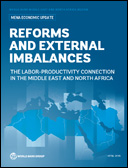Wednesday 3 April 2019
Continued Reforms Needed in Middle East to Increase Labour Productivity
Keywords: PDF, World Bank
WASHINGTON (World Bank press service) — Economic growth in the Middle East and North Africa (MENA) region is set to drop slightly to 1.5% in 2019 from 1.6% in 2018, according to a new World Bank report. Despite the fall in growth this year, regional growth is expected to see a modest uptick to 3.4% in 2020 and 2.7% in 2021.

- Reforms and External Imbalances (PDF)
- The labor-productivity connection in the Middle East and North Africa (Click to download)
The World Bank’s latest bi-annual MENA Economic Update, launched Monday, says the expected growth in the region is led by developing oil importers, such as Egypt, which accounts for roughly 8% of MENA’s GDP, with a forecast at 5.5% in 2019, and higher in 2020-2021 Growth in GCC economies is expected to reach 2.1% in 2019. The revival of growth in Egypt and the GCC is partly and indirectly the result of domestic reform policies. Meanwhile, the expected growth slowdown of MENA’s largest export markets, namely, the EU, US and China, will have a negative effect on the region.
“We’re challenging the region to embrace ambitious reforms”, said Ferid Belhaj, World Bank Vice President for the Middle East and North Africa Region. “There’s an urgency today for reforms to improve productivity and encourage innovation and competition. The Middle East and North Africa will have 300 mln young people looking to enter the job market by 2050. The region can only succeed if it addresses the structural impediments to growth. We see that the countries that have taken difficult measures to implement policy reforms are the drivers of economic growth in MENA today.”
The modest expected pickup in growth in the upcoming years does not change the long-term picture of lackluster growth of GDP per capita and persistent current account deficits in several developing economies of MENA. Many oil-importing countries have been running large and persistent trade and current account deficits for more than a decade. In contrast, MENA’s oil exporters have historically had large current account surpluses, but that has changed in recent years. The deterioration in external balances has limited the ability of the region to re-circulate savings from high-income oil exporters to developing economies with persistent current account deficits, most notably since the global restructuring of the oil market in 2014.
The new Bank report, entitled Reforms and External Imbalances: The Labour-Productivity Connection in the Middle East and North Africa, lays out the urgent need for more structural reforms that can raise aggregate labour productivity to simultaneously raise growth and reduce external imbalances in the region.
“MENA countries should be growing at least at twice the rates they currently do”, said Rabah Arezki, World Bank Chief Economist for the Middle East and North Africa Region and lead author of the report. “To awaken its untapped potential, the region must transform its economies, strengthen market contestability, and adopt a moonshot approach to the digital economy.”
Existing excess current account deficits must shrink gradually, the report argues, rather than wait until souring capital flows force current account deficit reversals upon MENA economies.
The report affirms that both demographic changes and aggregate labour productivity are fundamental drivers of an economy’s current account balance. Structural reforms are urgently needed to raise aggregate labour productivity. These reforms include: fiscal-expenditure reforms that can help by both increasing fiscal savings and enhancing labour productivity when subsidies prevent market contestability; trade reforms aimed at lowering trade costs beyond tariffs to help integrate MENA in global value chains; labor market reforms to enhance labour productivity while also providing a safety net for displaced workers; and smart reforms in State Owned Enterprises in network industries, such as energy and telecoms to help improve the efficiency of the firms as well as raise aggregate labour productivity.

